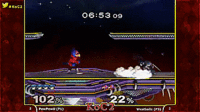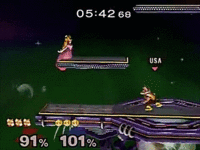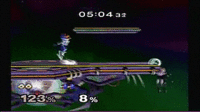Mindgame
In the Super Smash Bros. series, mindgames are strategies or techniques employed for the purpose of outwitting opponents psychologically. Alongside technical skills, mindgames constitute players' play-styles, and are considered to be an important counterpart of technical skill in competitive play.
Examples
The following are types of mindgames that have been used, described and defined by the Smash community.
Predicting
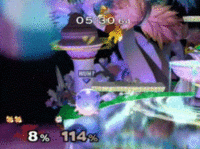
Predicting an opponent's option is the most basic example of a mindgame. It involves observing an opponent's behaviour and discerning habitual patterns in their play-style, then predicting these actions and punishing them. Successfully predicting a player's action is commonly referred to as a read, and furthermore, there are two types of reads: a soft read and a hard read. The relationship between the types of reads is a matter of risk versus reward; a soft read occurs when a player punishes an opponent's options while covering other options (often resulting in sub-optimal punishment), whereas a hard read occurs when a player specifically reads a single option with its optimal punishment but at the expense of not covering other choices the opponent could have made. An example of a soft read would be covering tech options. For example if an opponent is put into a tech chase, he or she only has four options: tech-rolling towards the player, tech-rolling away from the player, a neutral tech, or missing the tech on purpose. By dash dancing near the opponent, a player effectively covers three of the four options: the neutral tech, the missed tech, and the tech roll towards the player, (since these three can be punished upon reaction). An example of a hard read would occur if in the scenario described above, the player picked one tech option and charged a smash attack in the location the opponent would end up after picked that said tech option. Such a example of a hard read occurs in the GIF to the right.
Baiting
Another example of a mindgame is baiting, also known as luring, which is a slightly more complex form of predicting and punishing. It involves tricking an opponent into putting themselves in a vulnerable position. This is done by recognizing and remembering an opponent's reaction to a particular situation and inducing that situation in order to punish their reaction. In other words, this is punishing a player's habits.
An example of baiting commonly seen in competitive play is punishing laser habits from Falco with powershielding. In Melee, many Falco mains fire lasers recklessly, or only fire lasers from a specific distance. By memorizing the timing and spacing a Falco player fires lasers at frequently, one can move to that spot, read the laser, and prepare to powershield the laser and follow it up with a grab or an aerial. In the GIF to the right, such a laser was baited, powershielded, and punished with a wavedash out of shield into a forward smash.
Template:Rosalina & Luma can bait opponents in a unique manner, as seen here. As Luma can still be controlled regardless of Rosalina's state, she can shield herself long enough to break her shield, baiting the opponent into attacking her while she is in a dazed state. Luma can then punish the opponent as the opponent comes to attack Rosalina.
Pressuring
Pressuring is the act of limiting an opponent's options in order to force them to react. Like baiting, pressuring is used to lure out some sort of punishable action, but the difference is the action is lured out more aggressively and the opponent's habits are not necessarily taken into account. An option commonly used to pressure is dash dancing. Dash dancing (in conjunction with wavedashing) allows players to threaten an opponent while simultaneously taking safe space away from them. If done properly, the opponent will be forced to take a very risky action to counter the dash dancing such as trying to hit the dash dancing player or roll through it. An example of successful dash dance pressure is shown to the right.
The most famous pressure seen in competitive play though is shield pressure, particularly with Fox and Falco in Melee. They can use their shines and fast aerials to threaten a shielding opponent with a shield break, and thus force the opponent to try and escape the shield. With a few exceptions, most out of shield options are risky and have very explicit periods of vulnerability, meaning they can be punished very easily if read. Shield pressure is used to lure out one of options to punish. An example of good shield pressure is shown in a GIF below.
Having difficulty dealing with pressure is a pretty big weakness for some characters, such as Yoshi, whose extremely limited OoS options without platforms and lack of reliable approach moves with considerable range gives him trouble against characters who can easily shield pressure him, and characters who can easily outrange his approaches (such as Kirby using his up tilt in Smash 64).
Spacing
Spacing is the technique of using one's movement and the threat of one's range relative to the opponent's to manipulate the positions of both players.
Unexpectedness
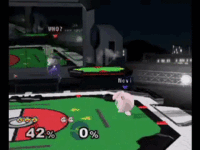
Sometimes, situations occur where an opponent does not cover an option because it is known by both players to be inferior to other options, or is otherwise thought to be something "they would never do". Recognizing that the opponent doesn't expect something can make it notably more effective. A common example is Ike's forward smash; while it should generally never be used without a read or a setup, successfully throwing it out when the opponent doesn't expect it can result in a surprise hit.

